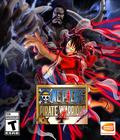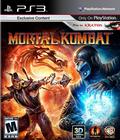In many ways, the ninth installment of the Mortal Kombat franchise is a homecoming of sorts. The lack of a numeral at the end of the title is no typo, as MK9 is, in a sense, a retelling of the series. The wheel hasn't been reinvented, and the fighters and story lines have stayed true to their original designs, but the surprisingly lengthy story mode retells of the plot from the original three Mortal Kombat games. The violent and campy signature of the game is still as prominent as ever, but rather than stand on the successive shoulders of previous releases, MK9 is the first franchise entry in some time that is capable of standing on its own.
From a storytelling standpoint, the beginning of MK9 takes place immediately after the events at the conclusion of Mortal Kombat: Armageddon. The camera slowly pans over a field of the viciously sundered and vulture-swarmed corpses of many of the series' Kombatants, eventually showing only Raiden and Shao Kahn battling it out atop a pyramid structure. The fight is brutal but one-sided, as Kahn pummels a bloodied Raiden to nearly his last breath. Clutching the pieces of a shattered amulet, Raiden sends a message back in time to his past self — "He must win!" — just as Kahn's hammer comes down with the killing blow.
Raiden's plea makes it back to his past self at the onset of the original Mortal Kombat tournament, along with a series of cryptic visions that flash by of various battling Kombatants. Slowly, Raiden finds that he must prevent the circumstances that surround these visions or risk events playing out just as they did in the original reality, with Shao Kahn claiming dominion over all. Thus, as the story mode progresses through the events of the first three Mortal Kombat games, there are many familiar events and signature fights, but they serve as a framework for the series of changes that Raiden attempts to make in the timeline.
Plots haven't exactly been a priority for the series, but MK9 bucks that trend in a pretty exceptional manner. The story line is still just as campy and unrealistic as you would expect (in all the good ways), but the developers have put forward significantly more effort in telling a story that incorporates the fighting rather than having it serve as mere window dressing for a fight ladder. In an unexpected twist, you don't get to pick your character beforehand, as the story mode is broken up into chapters, and you play as a new character in each chapter. For example, at the onset of the story, you play a few fights as Johnny Cage and then switch to Sonya Blade after he unsuccessfully woos and fights her. Between bouts, cinematics develop the story just enough to keep the plot threads juggled and feeling fresh without making the fights take a back seat.
However, this method of storytelling has its pros and cons. As the story bounces along and you play as various Kombatants, it serves as an excellent way for newcomers to play through all of the fighters in sequence and check out which ones they like. At the start of a new chapter, it feels like the game goes just a tad easier on you for about a round before turning the screws back up, so you have a honeymoon period to get a feel for how the character handles. Conversely, a chapter always seems to end just about the time a character starts to click for you, and you're forced to learn a new character again. It's worse if you find that you don't enjoy playing as a particular Kombatant, as you must muddle through the fights until you reach the next chapter. Ultimately, the high points of this progression method outweigh the lows, but unless you genuinely love playing as every Kombatant, there will be times when you simply can't wait for the chapter to be over.
Regardless of the new story mode arrangement, the fighting is what ultimately takes center stage in MK9. The core mechanics of the game are not overwhelmingly different than that found in previous titles, though there are a few interesting exceptions. The button layout is now geared around front and back punches — signifying the limb from which the strike is coming — rather than weak and strong. Other mechanics — such as blocks, ducks and jumps — are still true to the rest of the series, so it's not a total revamp. The graphics are in 3-D but the combat takes place on a 2-D plane, so there is no sidestepping or rotation around the arena.
The fighting is still pretty briskly paced, both in its speed and in how quickly you must input button combinations to successfully land moves. Reaction time is as critical as ever, as reading and reacting to just a few frames of your opponent may be the only "tell" you get to prepare for his upcoming move. This makes every round a chaotic affair as both fighters fling moves at each other, block what they can of the incoming damage, counter out of combos and grabs, and try to outwit one another.
A new feature is the inclusion of an energy meter at the bottom of the screen that fills up when you take damage, block damage, or perform a selection of other actions. This bar has three sections that fill up in succession, and as you do so, a handful of special abilities unlock for use. At one full bar, you can overcharge any of your character's special abilities, making them deal more damage or have a larger projectile or effect. At two bars filled, you can engage a combo breaker by pressing back and block just after the first hit of a combo lands; this stops your opponent's combo and briefly staggers him. Finally, at three full bars, you can perform your character's X-ray move, some of which rival the brutality you'd normally see in a fatality.
Landing an X-ray move briefly slows down the game as the camera zooms in and the center of the field of vision gains X-ray vision. As it does so, you basically batter the opponent in horrific fashion, caving in his face with your boot, stabbing him through the eye socket with a blade, or stomping on his chest to break ribs and crush organs. These moves deal incredible damage and can help turn the tide of a fight, but by the same token, since using an energy move drains the entire bar, you must avoid doing any enhanced special moves or combo breakers to save up for one. Even then, it can take a full round before you fill up the bar to do one, so it is rare to see more than a pair of X-ray moves in a set of rounds.
Sometimes, you'll need all the abilities you can to turn the tide of a battle, as the difficulty of the game in both its AI and simple design can vary between being competitive, a cakewalk, and masochistic. Half of the fights seem to be pretty balanced, as the AI certainly pokes holes in your ability to fight back, adapts to some of your tactics, and makes you feel that you must earn your wins. At other times, you can simply grab the opponent over and over for an entire round with nary a block break to be seen (though it's easily done regardless of your energy level) or similarly cheese them with moves to which even a novice human opponent would begin to adapt.
Alternatively, some of the fights are just ridiculously difficult because of either the AI spiking up in intensity or overzealous design. Some fights, like Goro in the earlier parts of the game, are simply tough due to his large health pool, and while it was considered to be a source of frustration back in the day, it seems to be expected now. Some skirmishes have you fighting two opponents who can tag in and out at will, while it is just your lone character fighting for your side. To win you must defeat both of them, each with full health bars, and then do so a second time to win two rounds and the fight.
There are many times in the story when this feels like a lost opportunity. Even in the tutorial, tag matches are shown off as a 2v2 fight, and the game goes over the basics of tagging in and out during special moves or calling in your partner to fire off a quick projectile before leaping off-screen. However, when you play as Sonya Blade in the story mode, you're forced to enter a 1v2 fight — even though Jax was standing right next to her before the fight began. Since Jax is a special forces operative and her commanding officer, you'd expect him to jump right into the fray to help his outnumbered subordinate instead of standing idly by and doing nothing.
Of course, the fatalities are not only back, but they have also seen more love in the form of a fatality training mode, which allows you to practice the necessary combinations and distance to pull off a character's first fatality. Characters have multiple fatalities, which must be found on your own, in proper series custom, but it's nice that you can learn how to perform them in a no-pressure environment. The moves are as gory as ever, as torsos are diced and blown apart, heads roll, and innards generally become outards. You only get to use fatalities outside of the story mode, though, which is a disappointment given the number of characters that you'll see. Killing characters would remove them from the plot if realism were the goal, but come on! When has that ever been the goal in the MK series?
Other modes, such as the challenge tower, can occupy your time and let you battle your way through up to 300 challenges. These include fights and the return of classic minigames, such as "Test your Might" and "Test your Sight." It's essentially the same concept as the challenge towers in previous games, and it's a nice way to string together fights without digging into the story mode. You'll still get some bells and whistles along the way.
When you take it all into consideration, Mortal Kombat is a pretty good entry into the series, namely for the surprisingly high-quality story mode, but it falls short in other areas. You'll spew vulgarities almost every time you have to choke down a 1v2 fight and when the AI suddenly gains near-psychic prediction abilities, but when it's an even 1v1 fight, the game is a lot of fun. The choice to essentially reboot the series was a wise one, and now is probably your best chance to get caught up with the Mortal Kombat story, short of replaying the originals. However, some truly asinine fights will certainly dull the enjoyment from time to time.
Score: 8.4/10
More articles about Mortal Kombat










 The newest chapter of the fight franchise marks a return to the series' mature presentation and a reinvention of its classic 2D fighting mechanic. Driven by an all-new graphics engine, the Fatality is back, presented in more gory detail than ever before, as well as a number of new gameplay features and a deep story mode.
The newest chapter of the fight franchise marks a return to the series' mature presentation and a reinvention of its classic 2D fighting mechanic. Driven by an all-new graphics engine, the Fatality is back, presented in more gory detail than ever before, as well as a number of new gameplay features and a deep story mode.
































